一、什么是 AAPT2
在 Android 开发过程中,我们通过 Gradle 命令,启动一个构建任务,最终会生成构建产物“APK”文件。常规 APK 的构建流程如下:
(引用自 Google 官方文档)
老版本的 Android 默认使用 AAPT 编译器进行资源编译,从 Android Studio 3.0 开始,AS 默认开启了 AAPT2 作为资源编译的编译器,目前看来,AAPT2 也是 Android 发展的主流趋势,学习 AAPT2 的工作原理可以帮助 Android 开发更好的掌握 APK 构建流程,从而帮助解决实际开发中遇到的问题。
AAPT2 的可执行文件随 Android SDK 的 Build Tools 一起发布,在 Android Studio 的 build-tools 文件夹中就包含 AAPT2 工具,目录为(SDK 目录/build-tools/version/aapt2)。
二、AAPT2 如何工作
在看 Android 编译流程的时候,我忍不住会想一个问题:
Java 文件需要编译才能生 class 文件,这个我能明白,但资源文件编译到底是干什么的?为什么要对资源做编译?
带着这个问题,让我们深入的学习一下 AAPT2。和 AAPT 不同,AAPT2 把资源编译打包过程拆分为两部分,即编译和链接:
编译:将资源文件编译为二进制文件(flat)。
链接:将编译后的文件合并,打包成单独文件。
通过把资源编译拆分为两个部分,AAPT2 能够很好的提升资源编译的性能。例如,之前一个资源文件发生变动,AAPT 需要做一全量编译,AAPT2 只需要重新编译改变的文件,然后和其他未发生改变的文件进行链接即可。
2.1 Compile 命令
如上文描述,Complie 指令用于编译资源,AAPT2 提供多个选项与 Compile 命令搭配使用。
Complie 的一般用法如下:
aapt2 compile path-to-input-files [options] -o output-directory/
复制代码
执行命令后,AAPT2 会把资源文件编译为.flat 格式的文件,文件对比如下。
Compile 命令会对资源文件的路径做校验,输入文件的路径必须符合以下结构:path/resource-type[-config]/file。
例如,把资源文件保存在“aapt2”文件夹下,使用 Compile 命令编译,则会报错“error: invalid file path '.../aapt2/ic_launcher.png'”。把 aapt 改成“drawable-hdpi”,编译正常。
在 Android Studio 中,可以在 app/build/intermediates/res/merged/ 目录下找到编译生成的.flat 文件。当然 Compile 也支持编译多个文件;
aapt2 compile path-to-input-files1 path-to-input-files2 [options] -o output-directory/
复制代码
编译整个目录,需要制定数据文件,编译产物是一个压缩文件,包含目录下所有的资源,通过文件名把资源目录结构扁平化。
aapt2 compile --dir .../res [options] -o output-directory/resource.ap_
复制代码
可以看到经过编译后,资源文件(png,xml ... )会被编译成一个 FLAT 格式的文件,直接把 FLAT 文件拖拽到 as 中打开,是乱码的。那么这个 FLAT 文件到底是什么?
2.2 FLAT 文件
FLAT 文件是 AAPT2 编译的产物文件,也叫做 AAPT2 容器,文件由文件头和资源项两大部分组成:
文件头
资源项
资源项中,按照 entry_type 值分为两种类型:
RES_TABLE 包含的是 protobuf 格式的 ResourceTable 结构。数据结构如下:
// Top level message representing a resource table.message ResourceTable { // 字符串池 StringPool source_pool = 1; // 用于生成资源id repeated Package package = 2; // 资源叠加层相关 repeated Overlayable overlayable = 3; // 工具版本 repeated ToolFingerprint tool_fingerprint = 4;}
复制代码
资源表(ResourceTable)中包含:
StringPool:字符串池,字符串常量池是为了把资源文件中的 string 复用起来,从而减少体积,资源文件中对应的字符串会被替换为字符串池中的索引。
message StringPool { bytes data = 1;}
复制代码
Package:包含资源 id 的相关信息
// 资源id的包id部分,在 [0x00, 0xff] 范围内message PackageId { uint32 id = 1;}// 资源id的命名规则message Package { // [0x02, 0x7f) 简单的说,由系统使用 // 0x7f 应用使用 // (0x7f, 0xff] 预留Id PackageId package_id = 1; // 包名 string package_name = 2; // 资源类型,对应string, layout, xml, dimen, attr等,其对应的资源id区间为[0x01, 0xff] repeated Type type = 3;}
复制代码
资源 id 的命令方式遵循 0xPPTTEEEE 的规则,其中 PP 对应 PackageId,一般应用使用的资源为 7f,TT 对应的是资源文件夹的名成,最后 4 位为资源的 id,从 0 开始。
RES_FILE 类型格式如下:
RES_FILE 类型的 FLAT 文件结构可以参考下图;
从上图展示的文件格式中可以看出,一个 FLAT 中可以包含多个资源项,在资源项中,Header 字段中保存的是 protobuf 格式序列化的 CompiledFile 内容。在这个结构中,保存了文件名、文件路径、文件配置和文件类型等信息。data 字段中保存资源文件的内容。通过这种方式,一个文件中既保存了文件的外部相关信息,又包含文件的原始内容。
2.3 编译的源码
上文,我们学习了编译命令 Compile 的用法和编译产物 FLAT 文件的文件格式,接下来,我们通过查看代码,从源码层面来学习 AAPT2 的编译流程,本文源码地址。
2.3.1 命令执行流程
根据常识,一般函数的入口都是和 main 有关,打开 Main.cpp,可以找到 main 函数入口;
int main(int argc, char** argv) {#ifdef _WIN32 ...... //参数格式转换 argv = utf8_argv.get();#endif //具体的实现MainImpl中 return MainImpl(argc, argv);}
复制代码
在 MainImpl 中,首先从输入中获取参数部分,然后创建一个 MainCommand 来执行命令。
int MainImpl(int argc, char** argv) { if (argc < 1) { return -1; } // 从下标1开始的输入,保存在args中 std::vector<StringPiece> args; for (int i = 1; i < argc; i++) { args.push_back(argv[i]); } //省略部分代码,这部分代码用于打印信息和错误处理 //创建一个MainCommand aapt::MainCommand main_command(&printer, &diagnostics); // aapt2的守护进程模式, main_command.AddOptionalSubcommand( aapt::util::make_unique<aapt::DaemonCommand>(&fout, &diagnostics)); // 调用Execute方法执行命令 return main_command.Execute(args, &std::cerr);}
复制代码
MainCommand 继承自 Command,在 MainCommand 初始化方法中会添加多个二级命令,通过类名,可以容易的推测出,这些 Command 和终端通过命令查看的二级命令一一对应。
explicit MainCommand(text::Printer* printer, IDiagnostics* diagnostics) : Command("aapt2"), diagnostics_(diagnostics) { //对应Compile 命令 AddOptionalSubcommand(util::make_unique<CompileCommand>(diagnostics)); //对应link 命令 AddOptionalSubcommand(util::make_unique<LinkCommand>(diagnostics)); AddOptionalSubcommand(util::make_unique<DumpCommand>(printer, diagnostics)); AddOptionalSubcommand(util::make_unique<DiffCommand>()); AddOptionalSubcommand(util::make_unique<OptimizeCommand>()); AddOptionalSubcommand(util::make_unique<ConvertCommand>()); AddOptionalSubcommand(util::make_unique<VersionCommand>());}
复制代码
AddOptionalSubcommand 方法定义在基类 Command 中,内容比较简单,把传入的 subCommand 保存在数组中。
void Command::AddOptionalSubcommand(std::unique_ptr<Command>&& subcommand, bool experimental) { subcommand->full_subcommand_name_ = StringPrintf("%s %s", name_.data(), subcommand->name_.data()); if (experimental) { experimental_subcommands_.push_back(std::move(subcommand)); } else { subcommands_.push_back(std::move(subcommand)); }}
复制代码
接下来,再来分析 main_command.Execute 的内容,从方法名可以推测这个方法里面有指令执行的相关代码。在 MainCommand 中并没有 Execute 方法的实现,那应该是在父类中实现了,再到 Command 类中搜索,果然在这里。
int Command::Execute(const std::vector<StringPiece>& args, std::ostream* out_error) { TRACE_NAME_ARGS("Command::Execute", args); std::vector<std::string> file_args; for (size_t i = 0; i < args.size(); i++) { const StringPiece& arg = args[i]; // 参数不是 '-' if (*(arg.data()) != '-') { //是第一个参数 if (i == 0) { for (auto& subcommand : subcommands_) { //判断是否是子命令 if (arg == subcommand->name_ || (!subcommand->short_name_.empty() && arg == subcommand->short_name_)) { //执行子命令的Execute 方法,传入参数向后移动一位 return subcommand->Execute( std::vector<StringPiece>(args.begin() + 1, args.end()), out_error); } } //省略部分代码 //调用Action方法,在执行二级命令时,file_args保存的是位移后的参数 return Action(file_args);}
复制代码
在 Execute 方法中,会先对参数作判断,如果参数第一位命中二级命令(Compile,link,.....),则调用二级命令的 Execute 方法。参考上文编译命令的示例可知,一般情况下,在这里就会命中二级命令的判断,从而调用二级命令的 Execute 方法。
在 Command.cpp 的同级目录下,可以找到 Compile.cpp,其 Execute 继承自父类。但是由于参数已经经过移位,所以最终会执行 Action 方法。在 Compile.cpp 中可以找到 Action 方法,同样在其他二级命令的实现类中(Link.cpp,Dump.cpp...),其核心处理的处理也都有 Action 方法中。整体调用的示意图如下:
在开始看 Action 代码之前,我们先看一下 Compile.cpp 的头文件 Compile.h 的内容,在 CompileCommand 初始化时,会把必须参数和可选参数都初始化定义好。
SetDescription("Compiles resources to be linked into an apk.");AddRequiredFlag("-o", "Output path", &options_.output_path, Command::kPath);AddOptionalFlag("--dir", "Directory to scan for resources", &options_.res_dir, Command::kPath);AddOptionalFlag("--zip", "Zip file containing the res directory to scan for resources", &options_.res_zip, Command::kPath);AddOptionalFlag("--output-text-symbols", "Generates a text file containing the resource symbols in the\n" "specified file", &options_.generate_text_symbols_path, Command::kPath);AddOptionalSwitch("--pseudo-localize", "Generate resources for pseudo-locales " "(en-XA and ar-XB)", &options_.pseudolocalize);AddOptionalSwitch("--no-crunch", "Disables PNG processing", &options_.no_png_crunch);AddOptionalSwitch("--legacy", "Treat errors that used to be valid in AAPT as warnings", &options_.legacy_mode);AddOptionalSwitch("--preserve-visibility-of-styleables", "If specified, apply the same visibility rules for\n" "styleables as are used for all other resources.\n" "Otherwise, all stylesables will be made public.", &options_.preserve_visibility_of_styleables);AddOptionalFlag("--visibility", "Sets the visibility of the compiled resources to the specified\n" "level. Accepted levels: public, private, default", &visibility_);AddOptionalSwitch("-v", "Enables verbose logging", &options_.verbose);AddOptionalFlag("--trace-folder", "Generate systrace json trace fragment to specified folder.", &trace_folder_);
复制代码
官网中列出的编译选项并不全,使用 compile -h 打印信息后就会发现打印的信息和代码中的设置是一致的。
在 Action 方法的执行流程可以总结为:
1)会根据传入参数判断资源类型,并创建对应的文件加载器(file_collection)。
2)根据传入的输出路径判断输出文件的类型,并创建对应的归档器(archive_writer),archive_writer 在后续的调用链中一直向下传递,最终通过 archive_writer 把编译后的文件写到输出目录下。
3)调用 Compile 方法执行编译。
过程 1,2 中涉及的文件读写对象如下表。
简化的主流程代码如下:
int CompileCommand::Action(const std::vector<std::string>& args) { //省略部分代码.... std::unique_ptr<io::IFileCollection> file_collection; //加载输入资源,简化逻辑,下面会省略掉校验的代码 if (options_.res_dir && options_.res_zip) { context.GetDiagnostics()->Error(DiagMessage() << "only one of --dir and --zip can be specified"); return 1; } else if (options_.res_dir) { //加载目录下的资源文件... file_collection = io::FileCollection::Create(options_.res_dir.value(), &err); //... }else if (options_.res_zip) { //加载压缩包格式的资源文件... file_collection = io::ZipFileCollection::Create(options_.res_zip.value(), &err); //... } else { //也是FileCollection,先定义collection,通过循环依次添加输入文件,再拷贝到file_collection file_collection = std::move(collection); } std::unique_ptr<IArchiveWriter> archive_writer; //产物输出文件类型 file::FileType output_file_type = file::GetFileType(options_.output_path); if (output_file_type == file::FileType::kDirectory) { //输出到文件目录 archive_writer = CreateDirectoryArchiveWriter(context.GetDiagnostics(), options_.output_path); } else { //输出到压缩包 archive_writer = CreateZipFileArchiveWriter(context.GetDiagnostics(), options_.output_path); } if (!archive_writer) { return 1; } return Compile(&context, file_collection.get(), archive_writer.get(), options_);}
复制代码
Compile 方法中会编译输入的资源文件名,每个资源文件的处理方式如下:
解析输入的资源路径获取资源名,扩展名等信息;
根据 path 判断文件类型,然后给 compile_func 设置不同的编译函数;
生成输出的文件名。输出的就是 FLAT 文件名,会对全路径拼接,最终生成上文案例中类似的文件名—“drawable-hdpi_ic_launcher.png.flat”;
传入各项参数,调用 compile_func 方法执行编译。
ResourcePathData 中包含了资源路径,资源名,资源扩展名等信息,AAPT2 会从中获取资源的类型。
int Compile(IAaptContext* context, io::IFileCollection* inputs, IArchiveWriter* output_writer, CompileOptions& options) { TRACE_CALL(); bool error = false; // 编译输入的资源文件 auto file_iterator = inputs->Iterator(); while (file_iterator->HasNext()) { // 省略部分代码(文件校验相关...) std::string err_str; ResourcePathData path_data; // 获取path全名,用于后续文件类型判断 if (auto maybe_path_data = ExtractResourcePathData(path, inputs->GetDirSeparator(), &err_str)) { path_data = maybe_path_data.value(); } else { context->GetDiagnostics()->Error(DiagMessage(file->GetSource()) << err_str); error = true; continue; } // 根据文件类型,选择编译方法,这里的 CompileFile 是函数指针,指向一个编译方法。 // 使用使用设置为CompileFile方法 auto compile_func = &CompileFile; // 如果是values目录下的xml资源,使用 CompileTable 方法编译,并修改扩展名为arsc if (path_data.resource_dir == "values" && path_data.extension == "xml") { compile_func = &CompileTable; // We use a different extension (not necessary anymore, but avoids altering the existing // build system logic). path_data.extension = "arsc"; } else if (const ResourceType* type = ParseResourceType(path_data.resource_dir)) { // 解析资源类型,如果kRaw类型,执行默认的编译方法,否则执行如下代码。 if (*type != ResourceType::kRaw) { //xml路径或者文件扩展为.xml if (*type == ResourceType::kXml || path_data.extension == "xml") { // xml类,使用CompileXml方法编译 compile_func = &CompileXml; } else if ((!options.no_png_crunch && path_data.extension == "png") || path_data.extension == "9.png") { //如果后缀名是.png并且开启png优化或者是点9图类型 // png类,使用CompilePng方法编译 compile_func = &CompilePng; } } } else { // 不合法的类型,输出错误信息,继续循环 context->GetDiagnostics()->Error(DiagMessage() << "invalid file path '" << path_data.source << "'"); error = true; continue; } // 校验文件名中是否有. if (compile_func != &CompileFile && !options.legacy_mode && std::count(path_data.name.begin(), path_data.name.end(), '.') != 0) { error = true; context->GetDiagnostics()->Error(DiagMessage(file->GetSource()) << "file name cannot contain '.' other than for" << " specifying the extension"); continue; } // 生成产物文件名,这个方法会生成完成的flat文件名,例如上文demo中的 drawable-hdpi_ic_launcher.png.flat const std::string out_path = BuildIntermediateContainerFilename(path_data); // 执行编译方法 if (!compile_func(context, options, path_data, file, output_writer, out_path)) { context->GetDiagnostics()->Error(DiagMessage(file->GetSource()) << "file failed to compile"); error = true; } } return error ? 1 : 0;}
复制代码
不同的资源类型会有四种编译函数:
CompileFile
CompileTable
CompileXml
CompilePng
raw 目录下的 XML 文件不会执行 CompileXml,猜测是因为 raw 下的资源是直接复制到 APK 中,不会做 XML 优化编译。values 目录下资源除了执行 CompileTable 编译之外,还会修改资源文件的扩展名,可以认为除了 CompileFile,其他编译方法多多少少会对原始资源做处理后,在写编译生成的 FLAT 文件中。这部分的流程如下图所示:
编译命令执行的主流程到这里就结束了,通过源码分析,我们可以知道 AAPT2 把输入文件编译为 FLAT 文件。下面,我们在进一步分析 4 个编译方法。
2.3.2 四种编译函数
CompileFile
函数中先构造 ResourceFile 对象和原始文件数据,然后调用 WriteHeaderAndDataToWriter 把数据写到输出文件(flat)中。
static bool CompileFile(IAaptContext* context, const CompileOptions& options, const ResourcePathData& path_data, io::IFile* file, IArchiveWriter* writer, const std::string& output_path) { TRACE_CALL(); if (context->IsVerbose()) { context->GetDiagnostics()->Note(DiagMessage(path_data.source) << "compiling file"); } // 定义ResourceFile 对象,保存config,source等信息 ResourceFile res_file; res_file.name = ResourceName({}, *ParseResourceType(path_data.resource_dir), path_data.name); res_file.config = path_data.config; res_file.source = path_data.source; res_file.type = ResourceFile::Type::kUnknown; //这类型下可能有xml,png或者其他的什么,统一设置类型为unknow。 // 原始文件数据 auto data = file->OpenAsData(); if (!data) { context->GetDiagnostics()->Error(DiagMessage(path_data.source) << "failed to open file "); return false; } return WriteHeaderAndDataToWriter(output_path, res_file, data.get(), writer, context->GetDiagnostics());}
复制代码
ResourceFile 的内容相对简单,完成文件相关信息的赋值后就会调用通过 WriteHeaderAndDataToWriter 方法。
在 WriteHeaderAndDataToWriter 这个方法中,对之前创建的 archive_writer(可在本文搜索,这个归档写创建完成后,会一直传下来)做一次包装,经过包装的 ContainerWriter 则具备普通文件写和 protobuf 格式序列化写的能力。
pb 提供了 ZeroCopyStream 接口用户数据读写和序列化/反序列化操作。
WriteHeaderAndDataToWriter 的流程可以简单归纳为:
IArchiveWriter.StartEntry,打开文件,做好写入准备;
ContainerWriter.AddResFileEntry,写入数据;
IArchiveWriter.FinishEntry,关闭文件,释放内存。
static bool WriteHeaderAndDataToWriter(const StringPiece& output_path, const ResourceFile& file, io::KnownSizeInputStream* in, IArchiveWriter* writer, IDiagnostics* diag) { // 打开文件 if (!writer->StartEntry(output_path, 0)) { diag->Error(DiagMessage(output_path) << "failed to open file"); return false; } // Make sure CopyingOutputStreamAdaptor is deleted before we call writer->FinishEntry(). { // 对write做一层包装,用来写protobuf数据 CopyingOutputStreamAdaptor copying_adaptor(writer); ContainerWriter container_writer(©ing_adaptor, 1u); //把file按照protobuf格式序列化,序列化后的文件是 pb_compiled_file,这里的file文件是ResourceFile文件,包含了原始文件的路径,配置等信息 pb::internal::CompiledFile pb_compiled_file; SerializeCompiledFileToPb(file, &pb_compiled_file); // 再把pb_compiled_file 和 in(原始文件) 写入到产物文件中 if (!container_writer.AddResFileEntry(pb_compiled_file, in)) { diag->Error(DiagMessage(output_path) << "failed to write entry data"); return false; } } // 退出写状态 if (!writer->FinishEntry()) { diag->Error(DiagMessage(output_path) << "failed to finish writing data"); return false; } return true;}
复制代码
我们再分别来看这三个方法,首先是 StartEntry 和 FinishEntry,这个方法在Archive.cpp中,ZipFileWriter 和 DirectoryWriter 实现有些区别,但逻辑上是一致的,这里只分析 DirectoryWriter 的实现。
StartEntry,调用 fopen 打开文件。
bool StartEntry(const StringPiece& path, uint32_t flags) override { if (file_) { return false; } std::string full_path = dir_; file::AppendPath(&full_path, path); file::mkdirs(file::GetStem(full_path).to_string()); //打开文件 file_ = {::android::base::utf8::fopen(full_path.c_str(), "wb"), fclose}; if (!file_) { error_ = SystemErrorCodeToString(errno); return false; } return true;}
复制代码
FinishEntry,调用 reset 释放内存。
bool FinishEntry() override { if (!file_) { return false; } file_.reset(nullptr); return true;}
复制代码
ContainerWriter 类定义在 Container.cpp 这个类文件中。在 ContainerWriter 类的构造方法中,可以找到文件头的写入代码,其格式和上文“FLAT 格式”一节中介绍的一致。
// 在类的构造方法中,写入文件头的信息ContainerWriter::ContainerWriter(ZeroCopyOutputStream* out, size_t entry_count) : out_(out), total_entry_count_(entry_count), current_entry_count_(0u) { CodedOutputStream coded_out(out_); // 魔法数据,kContainerFormatMagic = 0x54504141u coded_out.WriteLittleEndian32(kContainerFormatMagic); // 版本号,kContainerFormatVersion = 1u coded_out.WriteLittleEndian32(kContainerFormatVersion); // 容器中包含的条目数 total_entry_count_是在ContainerReader构造时赋值,值由外部传入 coded_out.WriteLittleEndian32(static_cast<uint32_t>(total_entry_count_)); if (coded_out.HadError()) { error_ = "failed writing container format header"; }}
复制代码
调用 ContainerWriter 的 AddResFileEntry 方法,写入资源项内容。
// file:protobuf格式的信息文件,in:原始文件bool ContainerWriter::AddResFileEntry(const pb::internal::CompiledFile& file, io::KnownSizeInputStream* in) { // 判断条目数量,大于设定数量就直接报错 if (current_entry_count_ >= total_entry_count_) { error_ = "too many entries being serialized"; return false; } // 条目++ current_entry_count_++; constexpr const static int kResFileEntryHeaderSize = 12; 、 //输出流 CodedOutputStream coded_out(out_); //写入资源类型 coded_out.WriteLittleEndian32(kResFile); const ::google::protobuf::uint32 // ResourceFile 文件长度 ,该部分包含了当前文件的路径,类型,配置等信息 header_size = file.ByteSize(); const int header_padding = CalculatePaddingForAlignment(header_size); // 原始文件长度 const ::google::protobuf::uint64 data_size = in->TotalSize(); const int data_padding = CalculatePaddingForAlignment(data_size); // 写入数据长度,计算公式:kResFileEntryHeaderSize(固定12) + ResourceFile文件长度 + header_padding + 原始文件长度 + data_padding coded_out.WriteLittleEndian64(kResFileEntryHeaderSize + header_size + header_padding + data_size + data_padding); // 写入文件头长度 coded_out.WriteLittleEndian32(header_size); // 写入数据长度 coded_out.WriteLittleEndian64(data_size); // 写入“头信息” file.SerializeToCodedStream(&coded_out); // 对齐 WritePadding(header_padding, &coded_out); // 使用Copy之前需要调用Trim(至于为什么,其实也不太清楚,好在我们学习AAPT2,了解底层API的功能即可。如果有读者知道,希望赐教) coded_out.Trim(); // 异常判断 if (coded_out.HadError()) { error_ = "failed writing to output"; return false; } if (!io::Copy(out_, in)) { //资源数据(源码中也叫payload,可能是png,xml,或者XmlNode) if (in->HadError()) { std::ostringstream error; error << "failed reading from input: " << in->GetError(); error_ = error.str(); } else { error_ = "failed writing to output"; } return false; } // 对其 WritePadding(data_padding, &coded_out); if (coded_out.HadError()) { error_ = "failed writing to output"; return false; } return true;}
复制代码
这样,FLAT 文件就完成写入了,并且产物文件除了包含资源内容,还包含了文件名,路径,配置等信息。
CompilePng
该方法和 CompileFile 流程上是类似的,区别在于会先对 PNG 图片做处理(png 优化和 9 图处理),处理完成后在写入 FLAT 文件。
static bool CompilePng(IAaptContext* context, const CompileOptions& options, const ResourcePathData& path_data, io::IFile* file, IArchiveWriter* writer, const std::string& output_path) { //..省略部分校验代码 BigBuffer buffer(4096); // 基本一样的代码,区别是type不一样 ResourceFile res_file; res_file.name = ResourceName({}, *ParseResourceType(path_data.resource_dir), path_data.name); res_file.config = path_data.config; res_file.source = path_data.source; res_file.type = ResourceFile::Type::kPng; { // 读取资源内容到data中 auto data = file->OpenAsData(); // 读取结果校验 if (!data) { context->GetDiagnostics()->Error(DiagMessage(path_data.source) << "failed to open file "); return false; } // 用来保存输出流 BigBuffer crunched_png_buffer(4096); io::BigBufferOutputStream crunched_png_buffer_out(&crunched_png_buffer); // 对PNG图片做优化 const StringPiece content(reinterpret_cast<const char*>(data->data()), data->size()); PngChunkFilter png_chunk_filter(content); std::unique_ptr<Image> image = ReadPng(context, path_data.source, &png_chunk_filter); if (!image) { return false; } // 处理.9图 std::unique_ptr<NinePatch> nine_patch; if (path_data.extension == "9.png") { std::string err; nine_patch = NinePatch::Create(image->rows.get(), image->width, image->height, &err); if (!nine_patch) { context->GetDiagnostics()->Error(DiagMessage() << err); return false; } // 移除1像素的边框 image->width -= 2; image->height -= 2; memmove(image->rows.get(), image->rows.get() + 1, image->height * sizeof(uint8_t**)); for (int32_t h = 0; h < image->height; h++) { memmove(image->rows[h], image->rows[h] + 4, image->width * 4); } if (context->IsVerbose()) { context->GetDiagnostics()->Note(DiagMessage(path_data.source) << "9-patch: " << *nine_patch); } } // 保存处理后的png到 &crunched_png_buffer_out if (!WritePng(context, image.get(), nine_patch.get(), &crunched_png_buffer_out, {})) { return false; } // ...省略部分图片校验代码,这部分代码会比较优化后的图片和原图片的大小,如果优化后比原图片大,则使用原图片。(PNG优化后是有可能比原图片还大的) } io::BigBufferInputStream buffer_in(&buffer); // 和 CompileFile 调用相同的方法,写入flat文件,资源文件内容是 return WriteHeaderAndDataToWriter(output_path, res_file, &buffer_in, writer, context->GetDiagnostics());}
复制代码
AAPT2 对于 PNG 图片的压缩可以分为三个方面:
PNG优化,有兴趣的同学可以看看
在完成 PNG 处理后,同样会调用 WriteHeaderAndDataToWriter 来写数据,这部分内容可阅读上文分析,不再赘述。
CompileXml
该方法先会解析 XML,然后创建 XmlResource,其中包含了资源名,配置,类型等信息。通过 FlattenXmlToOutStream 函数写入输出文件。
static bool CompileXml(IAaptContext* context, const CompileOptions& options, const ResourcePathData& path_data, io::IFile* file, IArchiveWriter* writer, const std::string& output_path) { // ...省略校验代码 std::unique_ptr<xml::XmlResource> xmlres; { // 打开xml文件 auto fin = file->OpenInputStream(); // ...省略校验代码 // 解析XML xmlres = xml::Inflate(fin.get(), context->GetDiagnostics(), path_data.source); if (!xmlres) { return false; } } // xmlres->file.name = ResourceName({}, *ParseResourceType(path_data.resource_dir), path_data.name); xmlres->file.config = path_data.config; xmlres->file.source = path_data.source; xmlres->file.type = ResourceFile::Type::kProtoXml; // 判断id类型的资源是否有id合法(是否有id异常,如果有提示“has an invalid entry name”) XmlIdCollector collector; if (!collector.Consume(context, xmlres.get())) { return false; } // 处理aapt:attr内嵌资源 InlineXmlFormatParser inline_xml_format_parser; if (!inline_xml_format_parser.Consume(context, xmlres.get())) { return false; } // 打开输出文件 if (!writer->StartEntry(output_path, 0)) { context->GetDiagnostics()->Error(DiagMessage(output_path) << "failed to open file"); return false; } std::vector<std::unique_ptr<xml::XmlResource>>& inline_documents = inline_xml_format_parser.GetExtractedInlineXmlDocuments(); { // 和CompileFile 类似,创建可处理protobuf格式的writer,用于protobuf格式序列化 CopyingOutputStreamAdaptor copying_adaptor(writer); ContainerWriter container_writer(©ing_adaptor, 1u + inline_documents.size()); if (!FlattenXmlToOutStream(output_path, *xmlres, &container_writer, context->GetDiagnostics())) { return false; } // 处理内嵌的元素(aapt:attr) for (const std::unique_ptr<xml::XmlResource>& inline_xml_doc : inline_documents) { if (!FlattenXmlToOutStream(output_path, *inline_xml_doc, &container_writer, context->GetDiagnostics())) { return false; } } } // 释放内存 if (!writer->FinishEntry()) { context->GetDiagnostics()->Error(DiagMessage(output_path) << "failed to finish writing data"); return false; } // 编译选项部分,省略 return true;}
复制代码
在编译 XML 方法中,并没有像前面两个方法那样创建 ResourceFile,而是创建了 XmlResource,用于保存 XML 资源的相关信息,其结构包含如下内容:
在执行 Inflate 方法后,XmlResource 中会包含资源信息和 XML 的 dom 树信息。InlineXmlFormatParser 是用于解析出内联属性aapt:attr。
使用 AAPT 的内嵌资源格式,可以在同一 XML 文件中定义所有多种资源,如果不需要资源复用的话,这种方式更加紧凑。XML 标记告诉 AAPT,该标记的子标记应被视为资源并提取到其自己的资源文件中。属性名称中的值用于指定在父标记内使用内嵌资源的位置。AAPT 会为所有内嵌资源生成资源文件和名称。使用此内嵌格式构建的应用可与所有版本的 Android 兼容。——官方文档
解析后的 FlattenXmlToOutStream 中首先会调用 SerializeCompiledFileToPb 方法,把资源文件的相关信息转化成 protobuf 格式,然后在调用 SerializeXmlToPb 把之前解析的 Element 节点信息转换成 XmlNode(protobuf 结构,同样定义在 Resources),然后再把生成 XmlNode 转换成字符串。最后,再通过上文的 AddResFileEntry 方法添加到 FLAT 文件的资源项中。这里可以看出,通过 XML 生成的 FLAT 文件文件,存在一个 FLAT 文件中可包含多个资源项。
static bool FlattenXmlToOutStream(const StringPiece& output_path, const xml::XmlResource& xmlres, ContainerWriter* container_writer, IDiagnostics* diag) { // 序列化CompiledFile部分 pb::internal::CompiledFile pb_compiled_file; SerializeCompiledFileToPb(xmlres.file, &pb_compiled_file); // 序列化XmlNode部分 pb::XmlNode pb_xml_node; SerializeXmlToPb(*xmlres.root, &pb_xml_node); // 专程string格式的流,这里可以再找源码看看 std::string serialized_xml = pb_xml_node.SerializeAsString(); io::StringInputStream serialized_in(serialized_xml); // 保存到资源项中 if (!container_writer->AddResFileEntry(pb_compiled_file, &serialized_in)) { diag->Error(DiagMessage(output_path) << "failed to write entry data"); return false; } return true;}
复制代码
protobuf 格式处理的方法(SerializeXmlToPb)在 ProtoSerialize.cpp 中,其通过遍历和递归的方式实现节点结构的复制,有兴趣的读者的可以查看源码。
CompileTable
CompileTable 函数用于处理 values 下的资源,从上文中可知,values 下的资源在编译时会被修改扩展为 arsc。最终输出的文件名为*.arsc.flat,效果如下图:
在函数开始,会读取资源文件,完成 xml 解析并保存为 ResourceTable 结构,然后在通过 SerializeTableToPb 将其转换成 protobuf 格式的 pb::ResourceTable,然后调用 SerializeWithCachedSizes 把 protobuf 格式的 table 序列化到输出文件。
static bool CompileTable(IAaptContext* context, const CompileOptions& options, const ResourcePathData& path_data, io::IFile* file, IArchiveWriter* writer, const std::string& output_path) { // Filenames starting with "donottranslate" are not localizable bool translatable_file = path_data.name.find("donottranslate") != 0; ResourceTable table; { // 读取文件 auto fin = file->OpenInputStream(); if (fin->HadError()) { context->GetDiagnostics()->Error(DiagMessage(path_data.source) << "failed to open file: " << fin->GetError()); return false; } // 创建XmlPullParser,设置很多handler,用于xml解析 xml::XmlPullParser xml_parser(fin.get()); // 设置解析选项 ResourceParserOptions parser_options; parser_options.error_on_positional_arguments = !options.legacy_mode; parser_options.preserve_visibility_of_styleables = options.preserve_visibility_of_styleables; parser_options.translatable = translatable_file; parser_options.visibility = options.visibility; // 创建ResourceParser,并把结果保存到ResourceTable中 ResourceParser res_parser(context->GetDiagnostics(), &table, path_data.source, path_data.config, parser_options); // 执行解析 if (!res_parser.Parse(&xml_parser)) { return false; } } // 省略部分校验代码 // 打开输出文件 if (!writer->StartEntry(output_path, 0)) { context->GetDiagnostics()->Error(DiagMessage(output_path) << "failed to open"); return false; } { // 和前面一样,创建ContainerWriter 用于写文件 CopyingOutputStreamAdaptor copying_adaptor(writer); ContainerWriter container_writer(©ing_adaptor, 1u); pb::ResourceTable pb_table; // 把ResourceTable序列化为pb::ResourceTable SerializeTableToPb(table, &pb_table, context->GetDiagnostics()); // 写入数据项pb::ResourceTable if (!container_writer.AddResTableEntry(pb_table)) { context->GetDiagnostics()->Error(DiagMessage(output_path) << "failed to write"); return false; } } if (!writer->FinishEntry()) { context->GetDiagnostics()->Error(DiagMessage(output_path) << "failed to finish entry"); return false; } // ...省略部分代码... } return true;}
复制代码
三、问题和总结
通过上文的学习,我们知道 AAPT2 是 Android 资源打包的构建工具,它把资源编译分为编译和链接两个部分。其中,编译是把不同的资源文件,统一编译生成针对 Android 平台进行过优化的二进制格式(flat)。FLAT 文件除了包含原始资源文件的内容,还有该资源来源,类型等信息,这样一个文件中包含资源所需的所有信息,于其它依赖接耦。
在本文的开头,我们有如下的问题:
Java 文件需要编译才能生.class 文件,这个我能明白,但资源文件编译到底是干什么的?为什么要对资源做编译?
那么,本文的答案是:AAPT2 的编译时把资源文件编译为 FLAT 文件,而且从资源项的文件结构可以知道,FLAT 文件中部分数据是原始的资源内容,一部分是文件的相关信息。通过编译,生成的中间文件包含的信息比较全面,可用于增量编译。另外,网上的一些资料还表示,二进制的资源体积更小,且加载更快。
AAPT2 通过编译,实现把资源文件编译成 FLAT 文件,接下来则通过链接,来生成 R 文件和资源表。由于篇幅问题,链接的过程将在下篇文章中分析。
四、参考文档
1.https://juejin.cn
2.https://github.com
3.https://booster.johnsonlee.io
作者:vivo 互联网前端团队-Shi Xiang
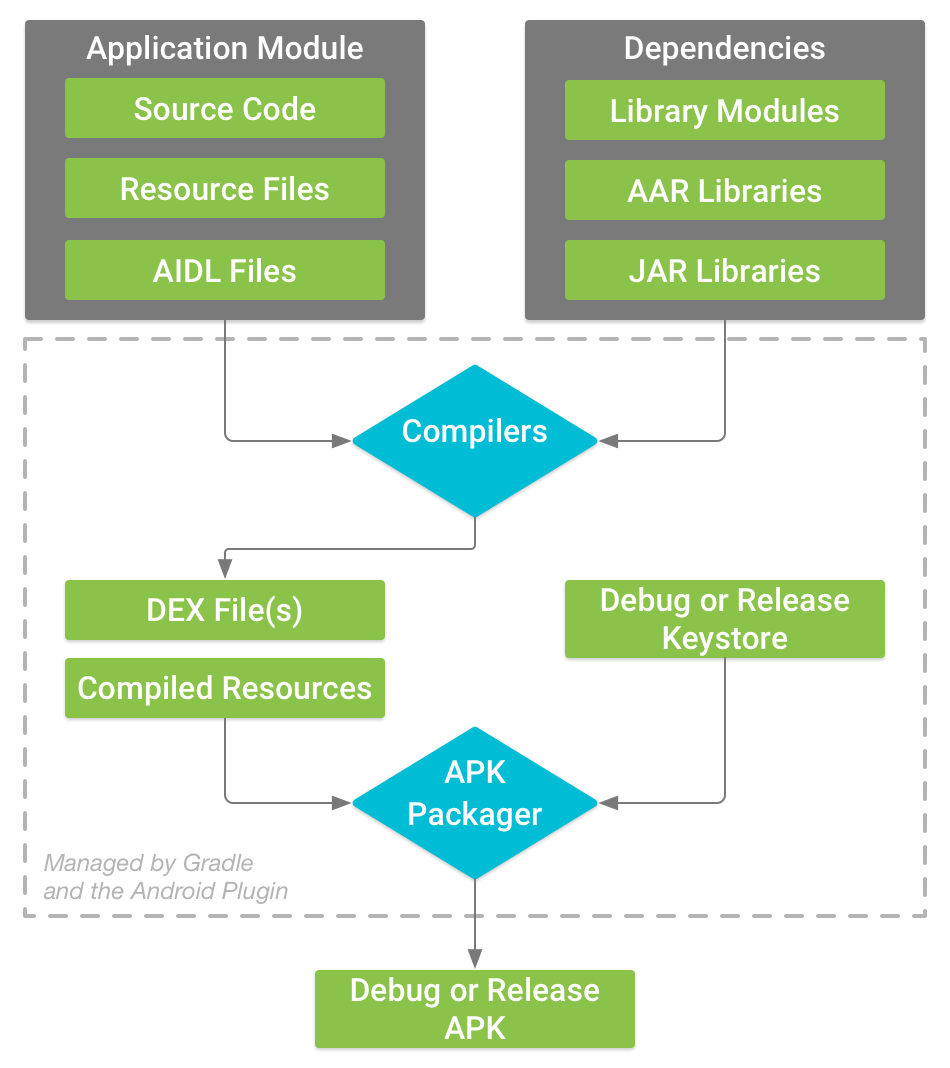
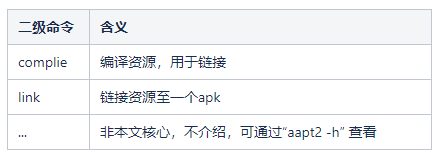
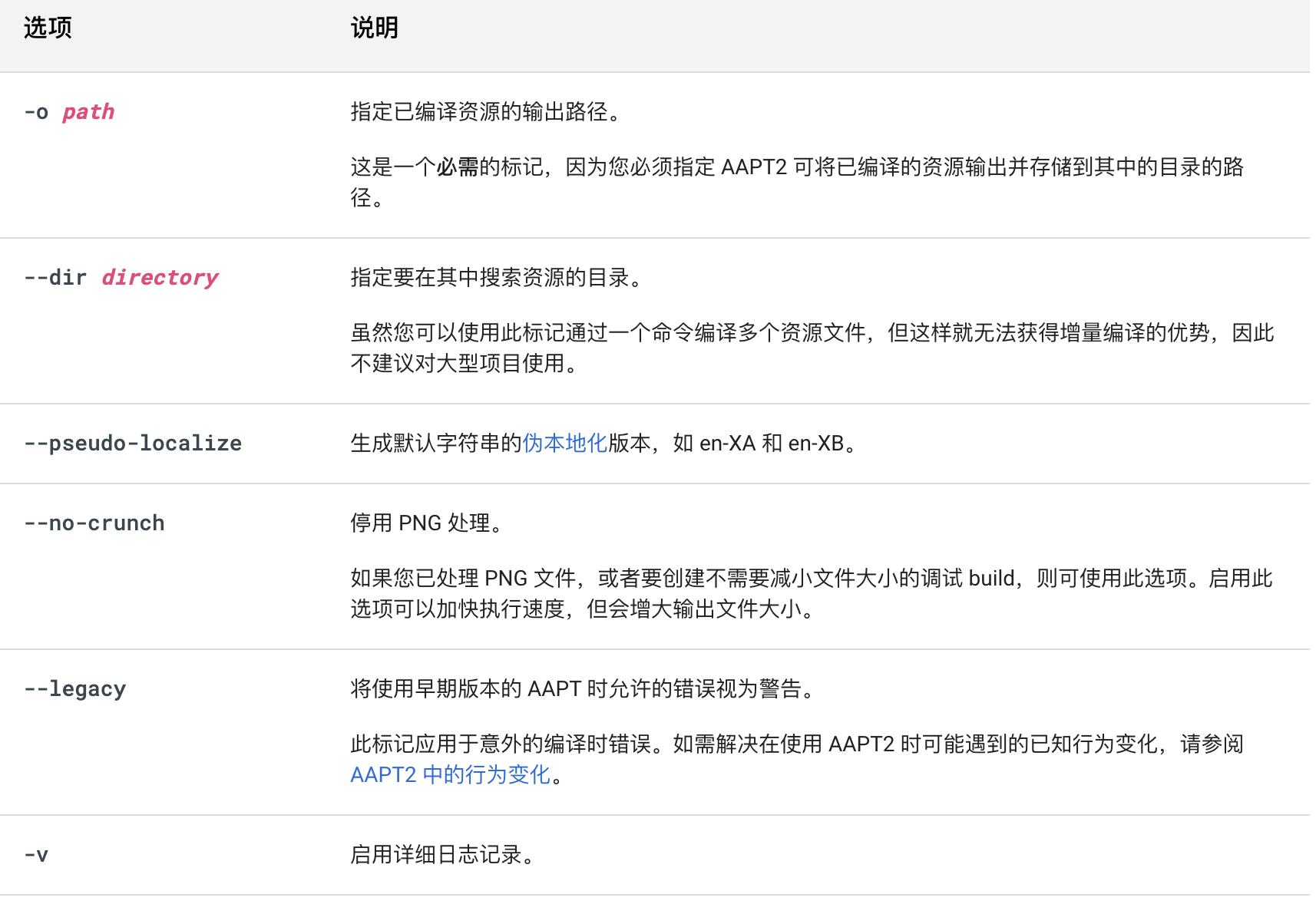

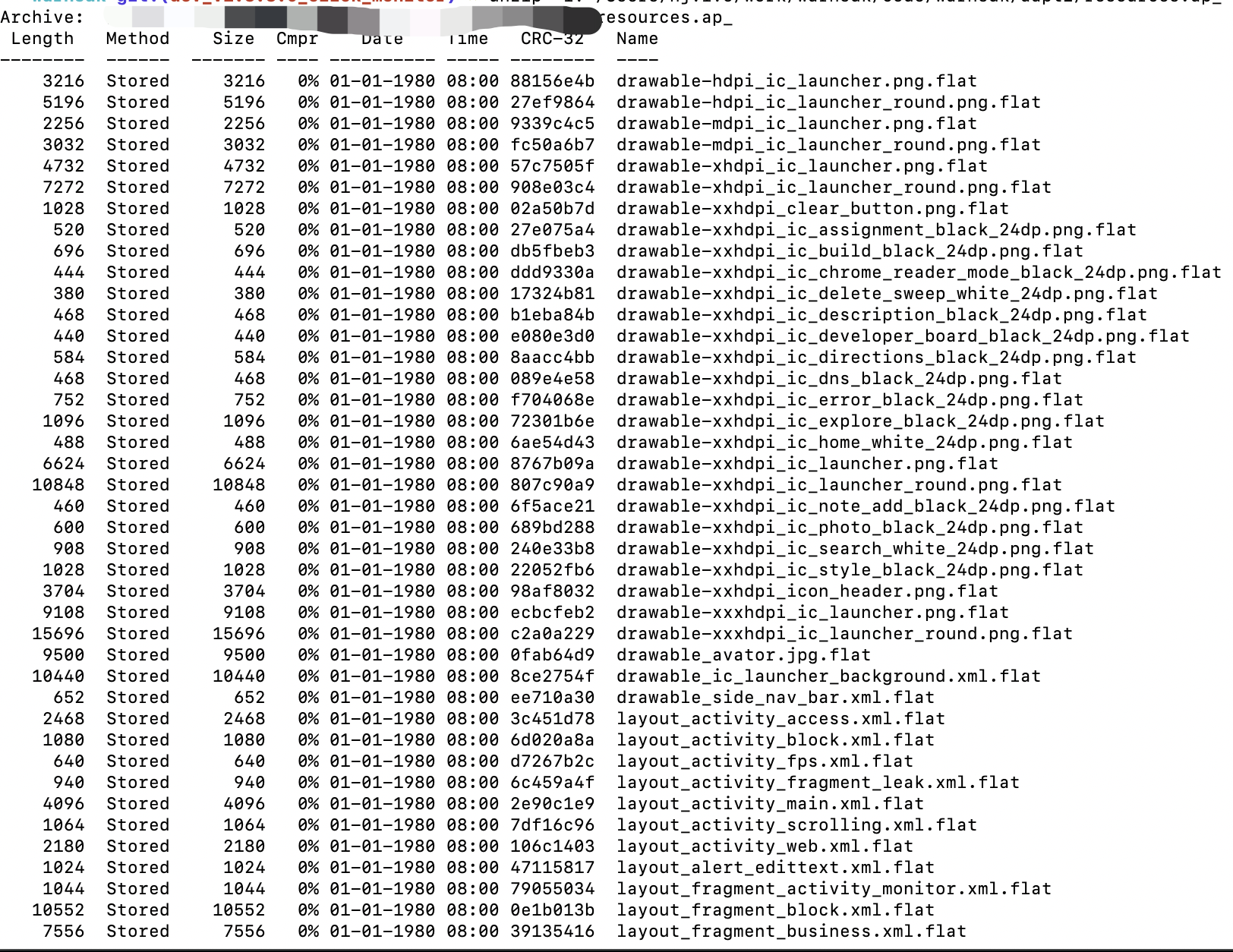


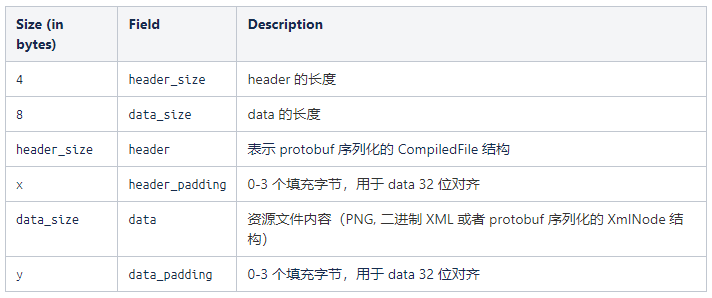
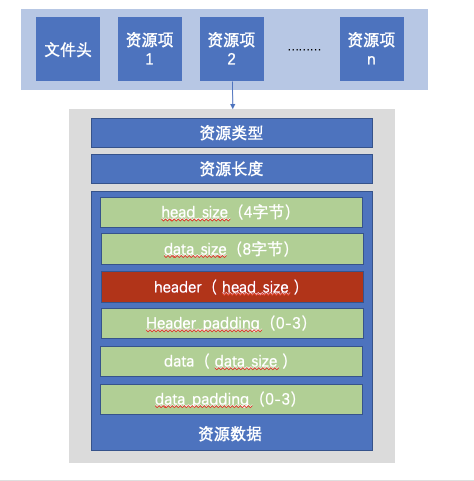


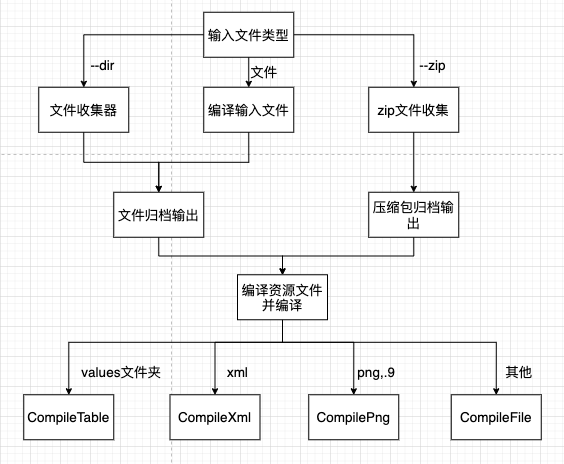














评论